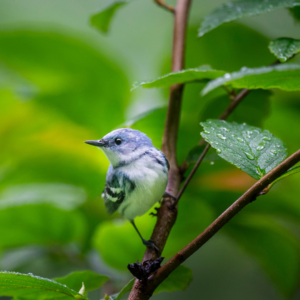4 Facts About the Cerulean Warbler You Need to Know: Species at risk series
Unless we act quickly, animals and plants labelled as a “species at risk” may disappear forever.
In our monthly species at risk series, we’ve talked about the Eastern cougar, the Algonquin wolf, and the ram’s head lady’s slipper orchid.
Today, we want to introduce you to the Cerulean Warbler.
Otherwise known as Dendroica cerulea, this little warbler is categorized as “threatened” in Ontario and Quebec. This means it still lives in the wild but is likely to become endangered if action isn’t taken soon to help this songbird thrive.
What do they look like?
This small songbird can grow to 12 centimetres in length, with a short tail but long wings.
Adult male and female Cerulean Warblers have distinctive colouring. Males are deep blue on top and a blue-black band across their throat. Females are blue-green on top with white to yellow parts underneath and similar coloured eyebrows. Both have white spots on their tails and wings.
Where do they live?
Summers are their breeding seasons, so you’ll find Cerulean Warblers stretched across southwestern Ontario and Quebec to Minnesota, Nebraska, Texas, and North Carolina. They prefer mature forests with tall, large trees and lots of room to roam.
They spend their winters in South America, nestled in the Andes Mountains.
In the Ottawa Valley, this songbird can be found primarily in two distinct areas:
- Between southern Lake Huron and western Lake Ontario
- Within the Bruce Peninsula and Georgian Bay area to the Ottawa River
 What threatens their survival?
What threatens their survival?
Forest degradation and fragmentation are the main threat to this warbler. These types of deforestation rely on large tracts of forest, meaning massive portions of habitat are removed.
Another threat to Cerulean Warblers is “nest parasitism” from invasive species. This is when another bird lays their eggs in this songbird’s nest. Specifically, the Brown-headed Cowbird will include their eggs into the warbler’s nest and the young cowbirds are fed at the expense of the warbler’s own young.
What can you do to help?
CPAWS-OV is dedicated to protecting wildlife in the Ottawa Valley and the nature they call home.
You can make this a reality by donating today and saying Thanks to Nature for all it does to provide ecosystems for our community’s species at risk.
Want to invite your friends and family to say Thanks to Nature with you? Create a profile to fundraise as a team.
